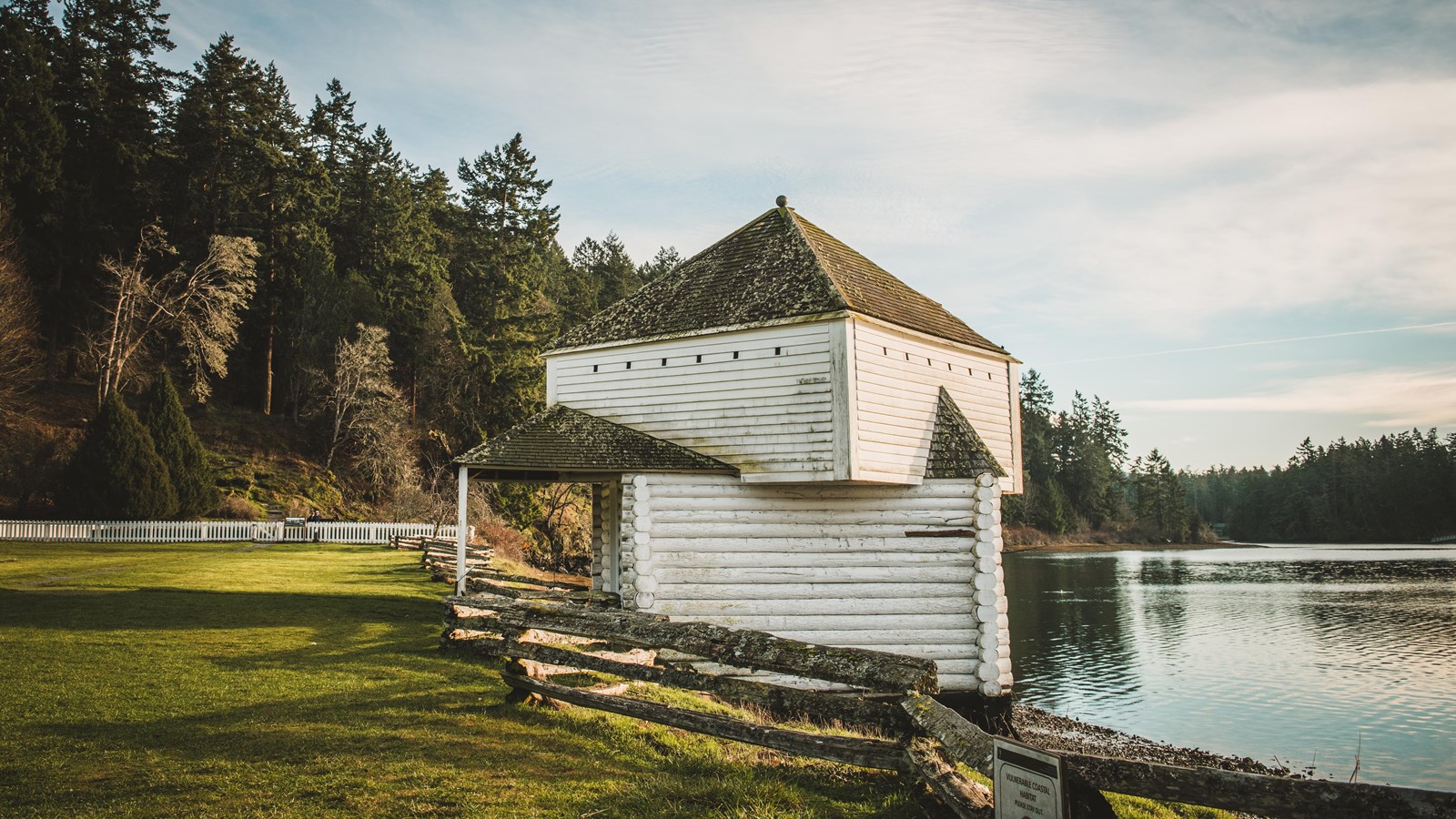Last updated: July 23, 2022
Place
Blockhouse

Kim Karu
Quick Facts
Location:
Friday Harbor, WA
Amenities
7 listed
Benches/Seating, Canoe/Kayak/Small Boat Launch, First Aid Kit Available, Historical/Interpretive Information/Exhibits, Information, Toilet - Vault/Composting, Trailhead
In December of 1872, one month after the English Royal Marines left San Juan Island, a team of American soldiers scrupulously examined the value of every building at English Camp. They declared the Blockhouse, “old and worthless.” From the 1875 until 1966 when San Juan Island National Historical Park was created, sheep grazed in front of the blockhouse, while their owner, farmer Jim Crook, preserved the Blockhouse. Though it has had to have its lower floors reconstructed due to saltwater infiltration from Garrison Bay on multiple occasions, it has stood at English Camp since 1860.
Officially designed as a fortification structure that could defend English Camp from attack, the blockhouse mostly acted as a place to confine civilians and soldiers who had broken laws or army rules. This blockhouse was likely based on the now nonexistent American Camp blockhouse which was originally a part of Fort Bellingham. Archaeological excavations also suggest that the blockhouse used to have a cobblestone porch and was surrounded by two sentry boxes where armed soldiers may have stood watch.The blockhouse never saw any combat activity. American and British forces developed an extremely friendly relationship from the very beginning of the joint occupation of San Juan Island in March of 1860. American soldiers and British soldiers regularly fraternized and delegations from English Camp traveled to American Camp to celebrate the 4th of July an Americans traveled to English Camp to celebrate the Queen’s Birthday.
The friendships between American and English officers and solders made it easier for both sides to administer law and order on San Juan Island. The island’s status as a place that was not subject to civilian law and its large population of soldiers encouraged smuggling and vice on the island. The commanders of both camps worked together to apprehend murderers, expel fraudsters, and regulate white residents who took advantage of Native Americans. Though their decision making, such as the lenient punishment that they gave to a man they believed murder multiple Coast Salish people, reflects the racial attitudes of their time, the cooperative attitudes of these two proud military forces is noteworthy for its time and ours.
Nearby the blockhouse are numerous other English Camp landmarks. Stop by the English Camp Barracks which serves as the site visitor center to see the site film and talk with a park ranger. Visit the formal garden to see a refined English landscape created far away from home. Hike the Bell Point and Young Hill trail to get a sense of the beautiful natural setting that English Camp is and was renowned for. Visit American Camp to see where American soldiers lived during the joint occupation of San Juan Island and learn how their lives differed from that of their British counterparts.
Officially designed as a fortification structure that could defend English Camp from attack, the blockhouse mostly acted as a place to confine civilians and soldiers who had broken laws or army rules. This blockhouse was likely based on the now nonexistent American Camp blockhouse which was originally a part of Fort Bellingham. Archaeological excavations also suggest that the blockhouse used to have a cobblestone porch and was surrounded by two sentry boxes where armed soldiers may have stood watch.The blockhouse never saw any combat activity. American and British forces developed an extremely friendly relationship from the very beginning of the joint occupation of San Juan Island in March of 1860. American soldiers and British soldiers regularly fraternized and delegations from English Camp traveled to American Camp to celebrate the 4th of July an Americans traveled to English Camp to celebrate the Queen’s Birthday.
The friendships between American and English officers and solders made it easier for both sides to administer law and order on San Juan Island. The island’s status as a place that was not subject to civilian law and its large population of soldiers encouraged smuggling and vice on the island. The commanders of both camps worked together to apprehend murderers, expel fraudsters, and regulate white residents who took advantage of Native Americans. Though their decision making, such as the lenient punishment that they gave to a man they believed murder multiple Coast Salish people, reflects the racial attitudes of their time, the cooperative attitudes of these two proud military forces is noteworthy for its time and ours.
Nearby the blockhouse are numerous other English Camp landmarks. Stop by the English Camp Barracks which serves as the site visitor center to see the site film and talk with a park ranger. Visit the formal garden to see a refined English landscape created far away from home. Hike the Bell Point and Young Hill trail to get a sense of the beautiful natural setting that English Camp is and was renowned for. Visit American Camp to see where American soldiers lived during the joint occupation of San Juan Island and learn how their lives differed from that of their British counterparts.
